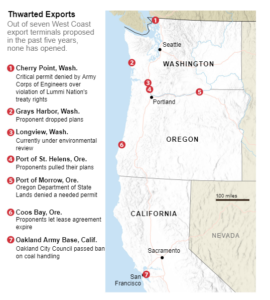by Andy May, May 17, 2018 in WUWT
U.S. coal production declined from 2011 through 2016 as it was displaced in U.S. power plants by cheaper and cleaner natural gas. Some of the reduction was also due to the Obama Clean Power Plan regulations. However, the shale gas revolution in the U.S. has not spread to other countries, perhaps due to the “fracking” scare, so worldwide use of coal increased rapidly until 2013. From 2000 until 2013 global coal use increased at a rate of over 4% per year. This led to an increase in U.S. coal exports (see Figure 1) because the U.S. is a low-cost producer of high quality coal. Coal consumption worldwide has flattened and is expected to stay flat through 2040, according to ExxonMobil’s 2018 Energy Outlook as well as the EIA. Currently coal provides 25% of the global energy supply and this is projected to decrease to 20% by 2040 according to ExxonMobil.

Figure 2. U.S. coal export terminal construction locations blocked by environmentalist lobbying. Source: The Wall Street Journal.
by S. Xu et al., December 2017, in AGU1000Biogeosciences
Coral bleaching is becoming a serious issue for coral reefs under the stress of global warming. However, whether it has occurred in the past in times of thermal stress remains unclear. Moreover, an understanding of historic coral bleaching events would greatly improve our insight into the adaptive capabilities of corals under such stresses. It is known that Porites corals, a massive coral, have relatively high levels of symbiotic zooxanthellae and a strong thermal tolerance when compared with most other corals (and particularly branched corals). Thus, growth hiatuses and/or mortality surfaces of fossil Porites may be used to indicate past ecological or environmental stress events, such as severe bleaching. In this study, monthly geochemical and isotopic environmental proxies of four fossil Porites corals with well‐preserved growth hiatuses and mortality surfaces (aged 3,800–4,200 years before 2013 A.D.), collected from Wenchang fringing reef, Hainan Island, Northern South China Sea were analyzed. Specifically, the Sr/Ca, δ18O, and δ13C were measured with a monthly resolution for each sample.
by Ron Clutz, May 16, 2018 in ScienceMatters
Thanks to GWPF for publishing posthumously Bill Gray’s understanding of global warming/climate change. The paper was compiled at his request, completed and now available as Flaws in applying greenhouse warming to Climate Variability This post provides some excerpts in italics with my bolds and some headers. Readers will learn much from the entire document (title above is link to pdf).
The Fundamental Correction
The critical argument that is made by many in the global climate modeling (GCM) community is that an increase in CO2 warming leads to an increase in atmospheric water vapor, resulting in more warming from the absorption of outgoing infrared radiation (IR) by the water vapor (…)

Figure 14: Global surface temperature change since 1880. The dotted blue and dotted red lines illustrate how much error one would have made by extrapolating a multi-decadal cooling or warming trend beyond a typical 25-35 year period. Note the recent 1975-2000 warming trend has not continued, and the global temperature remained relatively constant until 2014.
by Q. Lejeune et al., April 23, 2018 in Nature
The effects of past land-cover changes on climate are disputed. Previous modelling studies have generally concluded that the biogeophysical effects of historical deforestation led to an annual mean cooling in the northern mid-latitudes, in line with the albedo-induced negative radiative forcing from land-cover changes since pre-industrial time reported in the most recent Intergovernmental Panel on Climate Change report. However, further observational and modelling studies have highlighted strong seasonal and diurnal contrasts in the temperature response to deforestation
(…)
by M. Khandekar, April 27, 2018 in TroyMedia
It’s been a long winter.
I should know. I’m a former climate research scientist at Environment Canada. And I was an expert reviewer for the United Nations’ International Panel on Climate Change (IPCC) and its 2007 Climate Change Report.
The wintry weather held its grip over most of Canada well into April, from Vancouver to St. John’s, as snow, freezing rain, ice pellets and ferocious winds hammered everyone. A few noteworthy wintry tales:
-
Calgary is set for record snowfall.
-
Edmonton set a record for continuous days of below-freezing temperatures this winter.
-
Most of the Canadian Prairies were still in winter-like weather mode in mid-April.
-
Toronto has recorded one of the highest numbers of Heating Degree Days at 3,485 and counting.
-
Atlantic Canada braced for more wintry weather with snow accumulation of 10 to 25 cm in mid-month.
This year’s winter could be the longest, snowiest and coldest in 40 years.
(…)
La géologie, une science plus que passionnante … et diverse


